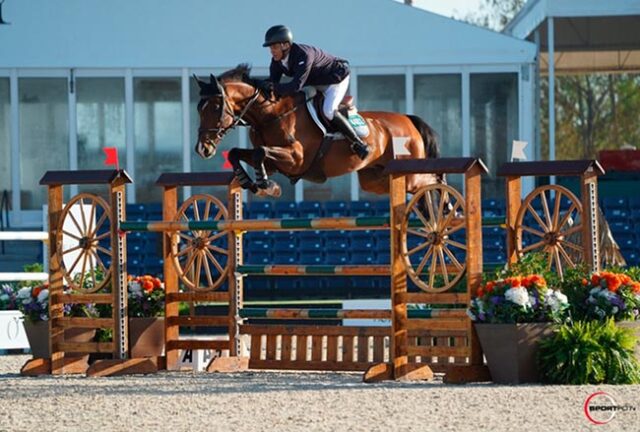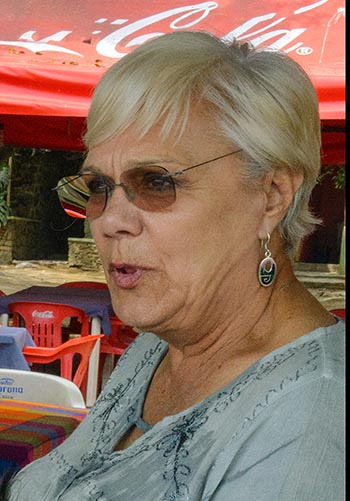
By Jean Llewellyn
Photography: Fito Tejada, private collection, Peter Llewellyn
A highly respected voice in equestrian sport, who can forget Linda Allen’s spectacular course designs at the Atlanta 1996 Olympic Games. Progressing through the ranks as a showjumping rider herself, Linda is now a popular coach, trainer and clinician, with a special affinity for young horses. For some time now, she has also been working as trainer and breeding consultant to some members of the Guatamalan national showjumping team who chose many years ago to breed and develop their own horses rather than buying ‘ready made’ jumpers.

Just recently, Leopoldo Palacios, also a well-known face of showjumping course design for five decades, was quoted as saying, “Course designing is changing a lot, like everything in life. There is development, but I’m not really sure that course designing is changing in a good way.”He continued by adding, “The fences today are not original. [...] I believe that today we are going a bit too far. The development is not good for the horses because of the increasing use of laboratories. I do not understand this – specialized technical training? At the end of the day our sport is a sport with animals that need to be near nature, not being developed in a laboratory. We need to come back to the roots and the nature of sport, because we have moved very far away from its nature.”
As the resident course designer at Spruce Meadows for over 25 years, Palacios speaks with passion about their adherance to grass competition rings, saying, “Natural fences and banks are so important for the sport. I like to make my fences ‘green’ with a lot of flowers,” a feature for which Spruce Meadows is famous.
Q Linda, how do your own thoughts compare with Leopoldo’s statements?
I very much agree with Leopoldo about the continuing evolution of the sport. At the top sport level I believe it starts with the courses and the venues, which then affects the training and development of horses, and finally affects the breeders as riders select horses that best suit today’s sport. Like most everything in the world, time brings changes to sport. Most of the changes are good ones such as safety cups and lighter material. Today’s public would never countenance horses falling as they did with regularity in the days of the Mexico City and Montreal Olympics. I feel, however, that many changes are not going in the right direction – or perhaps they have gone too far down the wrong path over the past two decades in particular.
I can’t, however, characterize it as being due to the ‘increasing use of laboratories’ as Leopoldo says. Certainly since we’ve gone away from natural footing, that aspect has moved from the days of virtual ‘artists’ with natural sand and wood products (such as Hermann Duckek whose talent gave us great footing for the 1996 Olympic Games in Atlanta, and the Agterberg brothers who accomplished the impossible for the WEG in The Hague), into today’s world of artificial products and attempts to develop laboratory science to determine what is ‘perfect’ footing for our sport.
In days past the ‘best’ showjumper was the horse that could display every aspect of his character and training: boldness, carefulness, clever turns, and ground-covering gallop. While the biggest classes were most always with one or two rounds preceding a jump-off, through the week a selection of different competitions with different scoring formats lent variety to the whole event – for the spectators and to bolster the education of the less experienced horses. We have moved increasingly away from this over the years, with the result that every rider is searching for the same type of horse for the one-round-one-jump-off format. With few exceptions jumps all look the same and the questions posed by each course are relatively limited. We are rapidly losing what many of us traditionalists feel was an important element in the sport’s appeal to the general public and horselover alike.
Q In terms of showjumping course designing over the past 30 years, what has driven its evolution?
I think the root cause comes down to what drives change in much of our world today, money. The level of prize money available in our sport today has made it possible for professional riders to earn a living one couldn’t even dream of 30 years ago. While this is great for those riders at the very top – and in a way it puts our sport in the same milieu as others such as tennis, golf, and motor sports – there have been many unintended consequences. That push toward sponsor-driven sport at the top is now affecting the sport at every level and in every aspect I believe.
In the past the flagship outdoor events all staged the competitions in venues that proudly displayed the sport in beautiful natural settings. Events such as Aachen, La Baule, Hickstead, Spruce Meadows, the Hampton Classic, etc., not only showed jumping horses in a natural way, each venue was unique and easily recognized by both competitors and fans by their jump material, natural obstacles, and decor. Many events had long histories, and with the passing of the years aspects were modified to meet the needs of modern sport but without losing the beauty of their unique nature. The appeal of the events wasn’t lost on the average person and these tournaments tended to draw huge crowds, creating many fans of equestrian sport that attend every year. Even the World Cup Finals in Goteborg presented the sport in an extravaganza of flowers and drew huge and enthusiastic crowds. Crowds of avid spectators I believe are the hallmark of most every legitimate sporting event... To read the complete article you need to be a subscriber
CLICK HERE TO SUBSCRIBE TO BREEDING NEWS
SUBSCRIBERS CAN READ THE COMPLETE ARTICLE BY LOGGING IN AND RETURNING TO THIS PAGE




